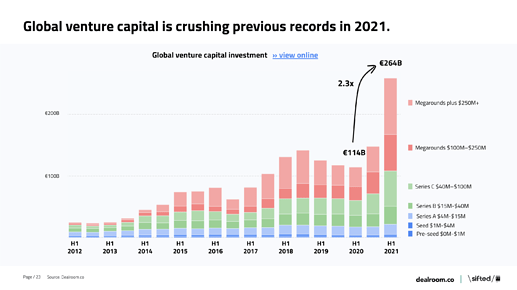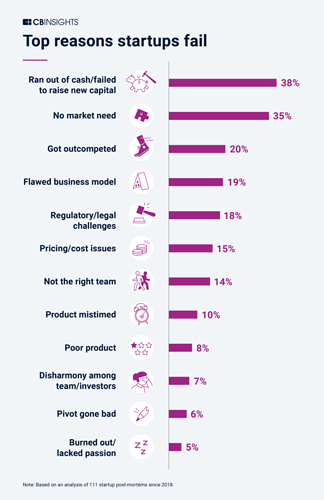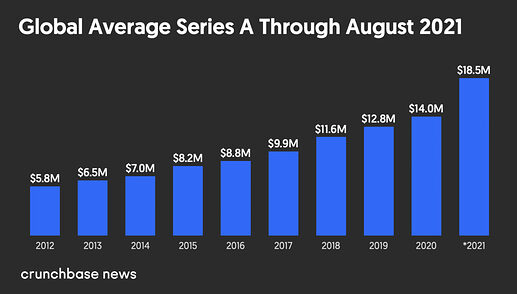Global startup funding has hit records highs, €264 billion ($305 billion) according to Dealroom data. Contrary to what people thought would happen post the pandemic, venture capital funding and deals have hit record highs. Just goes to show the amount of liquidity that’s hunting for yield.
According to Pitchbook data, there’s $1.3 trillion worth of PE dry powder - uninvested capital - waiting to be deployed. That’s a staggering number even if half of it is deployed. Meaning, this party might last a very long time.
But the thing about startup investing is, it’s extremely risky. Ok, saying it’s risky would be the understatement of the decade. 70% of upstart tech companies fail, usually around 20 months after first raising financing. 70%, damn!
According to the report by CB Insights, here the top reasons for start-up failures:
Here are some of the most high profile start-ups failure and what went wrong:
Theranos; If you have been following the news closely, this one’s been the most talked-about recently as the trial of the founder and CEO Elizabeth Holmes’ started recently.
Theranos was a medical tech start-up founded in 2003. Theranos claimed to have developed technology that could perform a range of health tests with just a small drop of blood. Theranos claimed that it would revolutionize the diagnostics industry.
Except there was only one problem. The technology didn’t work.
Things started unraveling for the company in 2015 when John Carreyrou, then a journalist at The Wall Street Journal first broke the story after a tip from a whistleblower in the company. The technology Theranos claimed to have developed repeatedly failed quality assurances. The results sent to real patients were fundamentally incorrect, upon which life-changing medical decisions were being made and Theranos was not using its own technology to run the majority of its tests due to the inefficiency of its own technology. It was followed by investigations by FDA (America’s Food and Drug Administration agency) which proved the allegations right.
The company’s founder and CEO Holmes and former president Ramesh Balwani stepped down in 2018 and were charged with criminal fraud for having allegedly misled investors and deliberately made false claims about the company’s blood-testing technology.
Few months later Theranos announced in an email to investors that it would shut down operations. The company had raised $700 million from investors and was valued at around $10 billion at its peak.
Recommend read for deeper dive into the Theranos saga; Book from John Carreyrou: Bad Blood - Secrets and Lies in a Silicon Valley Startup
Katerra:
Katerra was an American technology-driven off-site construction company, aimed to bring design, supply, and manufacturing into one business model and streamline the construction process, and had the vision to become a one-stop-shop for building materials and was backed by SoftBank who had invested $2.2 billion in the startup.
Despite its high ambitions and funding, things did not go as planned for the company, it drifted from its core vision and was not only making design software, air conditioning systems, and windows, but also engaging in general contracting, architectural design, engineering, and project management. It even provided cleaning services. The company ran into all sorts of problems,
ranging from defects in factory-produced materials to allegations of poor corporate governance.
The company finally had to file for bankruptcy. The company blamed its downfall on the pandemic, its inability to raise more money, and the “unexpected insolvency” of a former lender. Though not named directly by the company, Greensill Capital, another SoftBank-backed start-up, was the major financier to Katerra, which too has filed for bankruptcy earlier this year.
That brings us to the story of Greensill Capital;
Greensill Capital was a UK and Australia-based financial services company. It was in the business of supply chain financing. For example, Mr. A buys goods from Mr. B. Typically, companies pay after a couple of months, meaning, Mr. B would only get the money after a month or two. This is where Greensill came into the picture. It would pay Mr. B the full amount minus a small discount and they collect the full amount from Mr. A later. This is nothing but invoice discounting.
Now, Greensill has to do more of these deals and can’t afford to wait months to recover the money. It would then securitize the receivables on the invoice and sell them to people. Most notably through Credit Suisse. Seems boring enough, if this is all Greensill did.
But, that wasn’t the case. It was lending based on sales that were yet to happen and creating invoices based on those hypothetical sales or future receivables. This is some next-level innovation. To round it all up, it managed to convince insurance companies to insure its receivables. But it turns out it had lent too much to certain people and concentrated its risk and things went wrong.
The next one is Juicero, this one I think might be one of the stupidest start-up ideas.
Mission? Juicero stated its mission was to help people attain optimal health by making it easier for them to consume fresh raw foods.
How? Well, Juicero collected fresh organic fruits and vegetables for the customers, prepared, and put them in special single-serve packets. The company also designed and manufactured Juicero Press, a Wi-Fi-connected juicer that used the single-serving packets of pre-juiced fruits and vegetables sold by the company to squeeze the juice out of them.
What went wrong? Well… For starters, Juicero sold its juicer for $400, which only worked only when connected to Wi-Fi. Also, the serving packet this company sold came with a QR code on each packet, so the juicer didn’t work unless you used the serving packet sold by the company, which cost around $8 per packet.
The final nail in the coffin came when Bloomberg News published a video that you could extract the juice out of these packets by simply squeezing them with your hands. Who needs a $400 machine when you can do it by hand? Soon after, the company went bankrupt.
Despite high rates of start-ups going under, that hasn’t deterred the VC funding landscape in the early stages. As the report from Crunchbase highlights, the Series A funding has increased prominently over the past few years:
Which is driven by the top funds in the industry, as the below chart explains:



